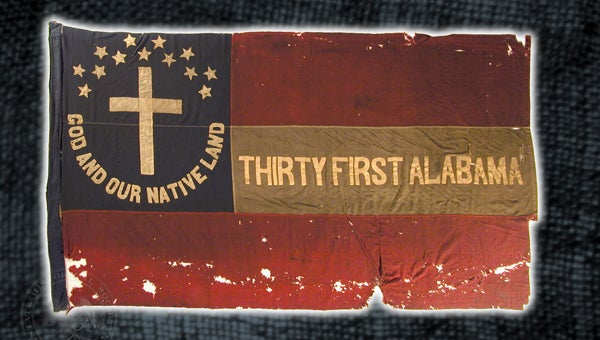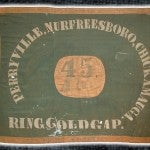
By Drew Granthum
A couple of local pieces of history have finally returned home after a lengthy time away.
Two flags that served as banners for Alabama battalions during the Civil War have been returned to Alabama from Iowa after nearly 150 years.
The flags haven’t been home since they were captured in battle seven score and nine years ago.
The flags, one belonging to the 31st Alabama Infantry and the other belonging to the 45th Alabama Infantry, have spent the last century-and-a-half in various spots in the Hawkeye State, most recently in the hands of the State Historical Society of Iowa.
From there, they caught the eye of Confederate Memorial Park director Bill Rambo.
“I had known about them for years,” he said. “In 2009, it occurred to me that the (Alabama) State Archives had just returned an Arkansas flag it had since 1905, and I thought ‘What the hay? Maybe Iowa can return ours.’”
The trek the two flags took in returning home is on par with that of Odysseus: full of mystery, defying the odds and trumping the fates.
Where so many similar flags from the era have disappeared or succumbed to the elements, these two managed to not only stand the test of time, but remain in wonderful shape in doing so.
The truly remarkable part of the flags’ story is not only that they made it, but also how much their return home is shrouded in mystery.
The flag resembling the original Stars and Bars from the CSA was the banner of the 31st Alabama Infantry, which served under Lt. Col. T.M. Arrington.
The original brigade was based out of Talladega, but included men from Calhoun, Cherokee, Montgomery, Randolph and Shelby counties as well.
The 31st fought in battles all across the South, but the point of interest pertaining to the flag is the Battle of Baker’s Creek (also known as Champion’s Hill).

The other flag sports a solid blue field with a white circle and a “45” in the middle, along with the names of three towns that were wins in battle, signifying that it was carried by the 45th Alabama Infantry. This group originated in Auburn, and was led by General Mark Lowrie at the Battle of Atlanta.
“They were captured near Atlanta on July 22, 1863 [the flag of the 45th] by the 15th Iowa Infantry, and at Baker’s Creek on May 16, 1863 [the flag of the 31st],” said Rambo.
Strangely, those are about the only concrete facts known about the flags until Rambo saw them in possession of the State Historical Society of Iowa some hundred years later.
“We really don’t know much about the flags after their capture,” he said. “After the war, they were supposed to turn the flags into the war department, and they’d number and ID them.”
Rambo said that these flags were never turned in, (which was required after 1905) as there are no War Department numbers on them, but that he has a pretty good idea of what happened to them.
According to Rambo, it was not uncommon for flags to go up the chain of command, and then instead of being turned into the war department, get kept for souvenirs.
“There was one Union general who had a lot,” he said. “He got some from the War Department, and used his influence to get flags. It could’ve been possible [that happened here].”
Regardless of how the flags wound up in Iowa in the first place, there still is the matter of how they got to the State Historical Society of Iowa, which is another mystery.
“My guess is as good as yours,” said Rambo. “We don’t know how they got them. There are no records of who donated them. Iowa has no province other than they are in a collection.”
The fact that the flags are in such great shape, especially that of the 45th, is hard for Rambo to believe.
“The Battle of Atlanta was a bloody, bloody fight,” he said. “The lack of bullet holes [is hard to fathom].”
The process of getting the flags took a bit of patience.
Rambo said that working with the historical society was a breeze, but working with the two state governments was not.
“I called the curator at the Iowa Historical Society, Sheila Hanke,” he said. “She was great to work with. She thought the [idea of the] flags coming back to Alabama was great. Everything government related is slow, and this time it was two governments. We had to be patient.”
So while the flags serve as two ghostly reminders of an era gone by, with a mystifying past that little is known about save by the flags themselves, Rambo remains hopeful that after 150 years away, they are here to stay.
“We have them on loan until 2015,” he said. “We hope to negotiate to keep them here.”
